Caribou Hunting (or
Not This Time!) |
This is the same page as the Moose Hunting page....we
had booked a caribou hunt with our moose hunt, but never tagged out
on moose, so we didn't get to head out to get in front of the caribou
heard! Maybe next time! |
|
|
| We decided to strike out into new territory by heading to Alaska
in September of 2004. We booked a hunt with Kniktuk Outfitters, based
out of Dillingham, Alaska. Dillingham is on the southwest coast of
Alaska. The hunt would be September 5-15. For moose, we would be
in a drop camp on a lake, with a guide and a packer. We could move
from place to place on the lake in an outboard motor skiff. For caribou,
we would be taken to the nearest camp to the herd (remember, caribou
migrate) We had tags for moose, caribou, and wolf. The area enjoyed
a 90% success rate of harvesting trophy bull moose.
We knew we were total rookies with regards to hunting anything in Alaska, so we did lots of reading and asked lots of questions. 1. Moose hunting means new hunting bullet: For previous elk/deer/bear hunts, we had chosen Combined Technology Ballistic Silver Tip 180 grain bullets because of how well they flew, even out to 1000 yards. However, their propensity to shatter when they hit bone on an elk or deer worried us. We'd never lost a trophy animal due to this, but what would these bullets do when they hit a moose? We kept having nightmares about the bullets simply bouncing off the moose's hide! We started developing a new load with a true "big game" bullet early summer of 2004. Talk about starting over! We tried every type of big game bullet we could find. Included on the list were the Nosler Partition, the Nosler Acubond, Lost River Ballistics, and the Barnes X Triple Shock. The Nosler bullets flew fairly well, but the smallest group at 100 yards was still 2 inches. The Lost River bullets were a huge disappointment, considering the hype that surrounds them. At $2.00 each, you'd expect laser accuracy. Well, our Nesika actions did NOT like these bullets. The best we could do was 6 inch groups at 300 yards. The Barnes X Triple Shock was a pleasant surprise. They grouped nicely at 100 yards, in developing the ideal powder load. We found they grouped to 1-2 inches at 300 yards. At 1000 yards, off bipods, we routinely could get 6 inch groups, with the occasional 4 inch group. Not bad! 2. Special equipment for Alaska OK, we now had the right bullet to harvest a trophy moose (or stop a charging brown bear!). Our outfitter sent us an equipment list for what we needed to bring with us to Alaska. Most items we already had. With a little help from Cabela's, we acquired the rest. Now--how do we get it there? How do we get the meat home? We were flying from Dallas to Seattle to Anchorage to Dillingham to get there, and from Dillingham to Anchorage to Chicago to Dallas to get home. We did NOT want to have to keep up with any more checked items than we had to, much less pay the airline fees for excess baggage! Cindy Wener (Kniktuk Outfitters) suggested we send everything we could via USPS Priority Mail. Meat in coolers could go as excess baggage on the return trip. So, off to the moving supplies store to buy the boxes. I packed the coolers with bedrolls, camp pillows, etc., and packed the boxes with the coolers and the rest of our hunting clothing/gear. We shipped the 4 boxes USPS Priority Mail; they got there in just 3 days! However, the postage fees were high. This was our first taste of the realities of expensive life in Alaska. 3. Getting us and our guns up there We had always flown in our own plane, or driven to, our hunts in the lower 48 states. What was it going to be like, flying the friendly skies with rifles? We had additional nightmares about the gun cases being bounced around like the gorilla in the Samsonite commercial! We were also terrified about the airlines losing our guns somewhere along the way. The possibility was very real, as we had to change planes twice to get there. Accordingly, we decided to arrive a day earlier than requested by Kniktuk, to allow for time for lost luggage and guns to catch up with us. We talked at length with the airlines, and carefully planned out what would go in each gun case. We also acquired a separate case for our ammo. By sending everything we could via USPS, we only had our 2 overnight bags, 2 gun cases, the ammo case, and a carry-on beach bag filled with our "technogeek" stuff (video camera, digital camera, satellite phone, etc.) to deal with on the plane. Our flight was at 9:30 am local on September 2. We arrived at the airport at 6:45 am, to make sure there was enough time to deal with any snafu's in relation to our firearms. Everything went very smoothly, though--by careful planning and following the rules/regs to the letter, the gun cases and ammo case were in full compliance. Both the airline personnel and the TSA personnel were very professional and helpful. The only alarming moment was when the TSA inspector couldn't figure out what the solar recharging panel for our satellite phone was! He laughed about it, once he figured it out, and promptly asked where he could get one, too! Getting to Dillingham from the lower 48 is a PAIN! It means sitting in airplanes for several hours at a time and seeing several airports. It also takes ALL day. However, we eventually got to Dillingham. So did our gun cases and our ammo case. However, Dale's overnight bag didn't make it. It seems there's a real problem with getting all the baggage onto the plane from Anchorage to Dillingham when the hunting season starts up, due to weight limitations and the sheer amount of stuff hunters carry with them. The airline assured us the bag wasn't lost, just couldn't go on the plane. It should be on the next flight--tomorrow! We opened our gun cases and made sure no obvious damage had occurred.
After putt After dropping off my overnight bag and the technical gear bag, we headed into Dillingham to scrounge up a meal. It was now 9 pm local, but midnight Texas time, and we hadn't eaten a proper meal all day! We discovered that Dillingham is too small to have any national fast-food or sit-down-restaurant chains represented, so we settled on a little place that advertised pizzas and Mexican food. (it confused us, though, as the owners were Japanese!) A third lesson in how expensive Alaska is followed: a medium pizza was $25; beer was $5. Wow! You could go broke in this town! The next morning, after a $50 breakfast, we went back out to the airport. Dale looked for his missing overnight bag while I opened up the boxes we had shipped up and started organizing our gear. Thank goodness I had logged what went into each box! In less than an hour, I was able to have our hunting clothes into our hunting duffle bags, our day packs organized, etc. Once Dale found the missing overnight bag, we would be ready to go! Unfortunately, the airline personnel were NO help AT ALL about the missing bag. At least a dozen other hunters, who had come in the previous day, were missing bags, boxes, even gun cases. Yikes! If Dale's bag was never found, at least all we'd have to do is buy him new socks, underwear and a toothbrush! Finally, late on Friday, September 3, Dale noticed a little black
overnight bag sitting all by itself off to the side in At any rate, we were now ready to go hunting. Renew Air Taxi was too busy to take us out to our camp site, so we had to spend the night in Dillingham again. We asked for a different bed-and-breakfast (we prefer to take showers where there are towels available!). Cindy Weiner set us up at Bear View Lodge--it was very comfortable, well set up, and, again, $160/night. It was our first hint of bad things to come with Kniktuk Outfitters--Friday, September 3, was when they wanted us to arrive in Dillingham, yet they didn't provide a place for their hunters to stay? Hmmmm.... 4. Let's go hunting! Satu Our camp was located on the shore of the lake, in a small inlet, sheltered from the wind. Our tent was small, but seemed adequate. After unpacking and settling in, we got out the paper target we'd brought, and checked the sight-in on the rifles at 300 yards. 2 shots each--nothin' but net! We're ready! We peppered Jim and Donny with questions the rest of the day about hunting in Alaska. Some interesting things came to light: Jim would carry a .375 H&H loaded with some wicked mean and nasty bullets; Donny would carry a 12 gauge riot gun, loaded with double-0 buck shot and slugs. Hmmm...Jim explained that the state of Alaska encourages back-up from the guide when a hunter is attempting to harvest a moose. In addition, brown bears can be a huge problem, especially when field-dressing a kill or packing out meat. Why did we leave our handguns in Texas? 5. The hunt begins--hip waders mandatory Sunday, September 5 dawned cold and cloudy. We left camp at first
walking light, about 7:00 am, walking north directly away from
shore. This first morning i We transitioned a small forest, climbed and descended a small hill, crossed a meadow--and spotted an old cow moose with twin calves. Things are looking up! After a long trudge across a mile-wide meadow (out of curiosity, I checked my pulse halfway across: 164 bpm, just walking across a marshy meadow, carrying a 25 lb pack and a 12 lb rifle--getting around in Alaska is WORK!), we climbed a 50 foot knob and set up to glass a 360 degree area. Suddenly, we spotted a young bull, way too small to be legal, running across the far edge of the meadow to the northeast of our vantage point. Even though he was not legal, and over 700 yards away, he was magnificent and HUGE! These moose are BIG! BAM! BAM! BAM! BAM! 4 shots rang out to our right, at least a half mile away. It was right in the vicinity where the other Kniktuk hunter, George, had planned on hunting that morning. We all exchanged big grins and thumbs up, thinking our fellow Kniktuk-er had already scored! We didn't see anything else the rest of the morning, and headed
in around 11 am. We were hungry--the camp had not been provisioned
properly with candy bars, snack foods, etc., like what all hunters
like to carry in their day packs. After scratching together a pea Our hearts collectively sank when we found out that there were at least 12 camps on the lake! The state of Alaska had limited the two lakes to the north of us, Chikuminuk and Upnuk, to 3 or 4 camps each, by permit only. Accordingly, the air taxi services out of Dillingham had dumped everybody who didn't have a permit on Chauekuktuli! The lake is long and slender, running east/west. The mountain range on the south side comes right down to the shore, leaving no suitable habitat for moose to hang out in, so no hunting on that side. The land on the north side of the lake rises gradually to the next mountain range, a distance of 1-2 miles. There are two valleys between mountains on the north side of the lake that can be hunted, and allow access up to the next lake. According to George, the other Kniktuk hunter's, calculations, with the number of moose tags on the lake, each hunter had about 1/4 square mile of shore line/meadows leading back to the mountains to hunt without encroaching on another hunter! OK: our camp isn't provisioned properly, and there's too many hunters around us: we knew it was going to be a long, tough hunt! 6. The hunt continues That evening, we jumped in the skiff and headed east on the lake.
In previous years, Jim had worked out a trail to the After a very strenuous 40 minute climb, we topped out on Gobbler's Knob. What a magnificent view! We had a panorama of meadows, narrow strips of forests, and small knobs laid out below us. The closest shots were 250 yards. We had clear fields of fire out to 1000+ yards. Dale and I exchanged a glance, and grinned--this looked REAL promising! Around 8:30 pm, we heard stomp-stomp-splash-splash: a cow moose
had just emerged from the forest just beneath the Knob, and was
feeding in the beaver pond immediately below us. Come on, Mr. Bull!
Unfortunately, all was quiet--no bull appeared, and the cow moose
lazily fed her way along until she was out of sight. No other game
animals appeared. We left at last light. Scrambling down that tough
trail by head lamp was an Monday morning, September 6, was cold, cloudy and damp. We took a short trip in the skiff at first light westward on the lake, and struck out inland on foot. We traversed a forest, coming out on the shore of a beaver pond complex. It is a NERVE-WRACKING experience to cross a beaver dam--they are NOT designed for human foot travel! However, we managed to teeter our way across and not end up IN the beaver pond. We ended up on a small knob about 50 feet above a large meadow complex. After glassing and watching for several hours, we started working our way through the meadows, looking for sign and movement. Unfortunately, Dale discovered the joys of travel in Alaskan marshes--he punched through the vegetation mat, not once but twice! Argh! This was one of the few times I've been glad of my small size and light weight--where Dale, Jim and Donny were in imminent danger of punching through, I could easily slip along without a worry! We headed back to camp to clean up, rest and eat (yes, you guessed it--pb&j sandwiches). That evening, we went back up Gobbler's Knob. Again, we saw the cow moose. In addition, a nice medium-sized brown bear came rolling through one of the meadows. Jim estimated the bear to be 8-10 foot, only 800 lbs or so. (!) Unfortunately, no other game animals were seen, so back down the trail we went after dark. We decided to be on Gobbler's Knob at first light on Tuesday, September 7. The day arrived cold and very wet. We spent a miserable 4 hours glassing for game. This drove home the fact that Dale and I did NOT have the right clothes for cold, wet, windy weather day after day. It was fun to see a Golden Eagle on the way back to camp, though. We headed back to camp at lunch-time, looking forward to a good,
hot meal. Kniktuk was to reprovision us that day. That evening, we headed back to the knob we'd been on Sunday morning. After a long, tough hike of 1 and 1/2 miles, we topped the knob only to see two other hunters already set up! They were as dismayed as us. By the time we got back to the shoreline, it was too late to head out to a different place to hunt. Accordingly, we scratched together another meal, and went to bed early. 7. The hungry times The hunt wore on, settling into a fairly predictable pattern. Day 4, Wednesday, September 8, dawned cold and wet. We elected to still-hunt the meadows to the north and west of Gobbler's Knob. We found tracks and sign everywhere we went, but didn't see or hear a single moose. On the way back to camp for lunch, we stopped at a drop camp 1/2 mile to the east of Phil and George's camp. We were introduced to the 5 hunters there, who turned out to be taxidermy clients of Jim's from Montana! We also found out one of them was who had shot the bull George was about to shoot. They had had NO idea Phil and George were on the bull, or they never would have shot him. After admiring the beautiful 56 inch rack, their wonderfully equipped and provisioned camp, we dragged back into our camp. We had the last of the rice for lunch. The evening hunt saw us back on the beaver pond area, on the little knob. Things got very exciting when we heard horns rattle and hoof steps. Unfortunately, it was a very young bull, no more than 30 inches on the spread. It was fun watching him and photographing him at only 100 yards. Again, no other game animals showed up. We headed back to camp at dark, and had the last of the chicken for supper. That night, we discovered our tent leaked. Day 5, Thursday, September 9, was the usual: cold and wet, with low hanging clouds. It didn't look like Bob could get in, weather-wise, to reprovision us (we assumed he was coming as promised). We headed back to the little knob in the beaver pond area. There, we placed Dale and Donny. Jim and I slipped on and walked the meadows to the north and east of where we left Dale and Donny. It was late enough in September now that the rut should have started, and the bulls should be talking. Jim and I would set up on the edge of a meadow, wait 30 minutes to let everything settle, and then start calling. Unfortunately, we never heard a bull answer. After a grinding tour of the meadows, we picked up Donny and Dale, and headed back to camp. Lunch consisted of the last of the bacon and pancakes, as we weren't reprovisioned yet. We spent the evening hunt of Day 5 on Gobbler's Knob. With windy,
wet, cloudy conditions, visibility was exceptionally poor. We were
exceptionally miserable, even in our rain suits (remember, we just
didn't have the right clothes for cold/windy/wet). After see Day 6, Friday, September 10 started out foggy, misty, rainy, cold and miserable. Typical Alaskan September weather! No way Bob Weiner could get in to reprovision us, either. We went very far west on the lake, to an area we hadn't been to. Jim said he had saved it for a last resort, because of the booger of a climb to get in. After an hour of fighting alder bushes, sliding, slithering and sweating, we emerged on a rocky knob over a little bowl--and immediately saw two cow moose just 200 yards away! We knew that, this time of year, two cow moose together meant a bull somewhere real close! The cows were quietly grazing, not spooked at all, so we had time to strip off our packs, get set up, and let our hearts quit racing from the brutal climb. After watching the cows for about 20 minutes, and carefully glassing the thick forest they were in for any other moose, we still hadn't seen any other moose. The cows started ambling away from us, working their way up a forested slope. When they were about 450 yards from us, Dale and Jim both spotted horns! Jim whispered urgently: "that's a good bull, take him if you can get a clear shot!" I finally found the bull in my binoculars, and ranged him at 467 yards. I told Dale I had him. Unfortunately, Dale thought I was on him with my rifle. Dale fired just as I was acquiring the bull in my scope, so I was unable to watch for any reaction to the bullet. The bull walked about 20 yards to the right, and stopped between two trees. I fired with the cross hairs at mid-body; I knew the bullet drop at 467 yards was around 16 inches, so my hold should place the bullet right in his wheelhouse. The bull disappeared from view, moving to the right. 5 minutes later, Donny had a glimpse of him walking at a 45 degree angle away from us, at about 650 yards. After a quick conference, we decided that Dale and Donny would stay on the rock, to guide us to the spot where the bull was when we fired. Jim and I dropped off the rock, and headed straight down the slope. More alder bushes! Argh! After a hair-raising descent, we worked our way to the spot where the bull was. Donny and Dale verified our location from the rock, and we verified the distance by ranging the rock. Jim and I worked carefully, gridding out the area, looking for blood, hair, bone, broken branches, scarred bark, anything. To our huge disappointment, we found absolutely nothing. In addition, where the bull was standing, both for Dale's shot and for mine, contained a large number of small branches and limbs. On a gray, rainy, misty day, these bullet obstructions would be completely unnoticeable in the poor visibility. To make things worse, it started a steady rain, guaranteed to wipe out a blood trail. We headed back to camp at mid-day, very dispirited. Lunch was equally dismal--we ate the last of the eggs. We went back to the same area for the evening hunt. We had noticed a knob to the west of the rock we had shot from that looked promising. After a brief, strenuous climb, we emerged on a small ridge. The ridge overlooked a river valley to the west, and a large bowl to the east. Glassing the bluffs across the river from us, about 1/2 mile away, revealed 3 more hunters. Hopefully, we wouldn't interfere with each other! Unfortunately, the steady rain turned into a torrential downpour.
I asked Jim just how much rain a moose will tolerate before he
beds down to ride it out. Jim replied, "not this much rain!" Accordingly,
we headed back to camp at only 8 pm. The long ride across the lake
in the downpour was culmina Dale and I talked at length that night, and asked Jim if we could skip the morning hunt on Day 7, Saturday, September 11, and just look for the bull. After a breakfast-less morning, we four gridded out the area and thoroughly checked for any sign of any kind. In addition, we found the place where he was last seen, spread out 15 yards apart, and walked a straight line until we ran into the mountains north of the lake, approximately a mile. Again, we found no sign of blood, bone, hair, body, etc. Finally, Dale and I were certain that we had, indeed, missed this bull, probably due to bullet deflection from all the shrubbery and branches around him. We headed back to camp at lunch-time in better spirits, and ravenously hungry. Unfortunately, no reprovision had occurred. However, we knew Bob had to reprovision his camps on each lake, and probably hadn't been able to do so the past 3 days due to weather. Typically, he would go to the farthest camps first, then work his way back. We were sure he just hadn't gotten to us yet. We figured we'd have a big pile of FOOD waiting for us when we got in from the evening hunt. The last of the ham as ham steaks made lunch. We decided to let the west area rest, and work over the beaver pond area again. Dale and Donny stayed on the little knob, and Jim and I worked our way to the far northeast meadow. At last light, after calling on and off for 30 minutes, we heard a horn whack against wood, but never saw the bull. We headed back at last light. Still no reprovision. Going supper-less to bed wasn't fun, but it was nice to be warm and almost dry again. Jim had been chewed out by Bob for calling him late (we typically didn't get in to camp until 11 pm), so Dale decided to call Bob on OUR satellite phone after the Sunday morning hunt. Day 8, Sunday, September 12 followed the now-usual pattern: cold, wet, windy, and no breakfast. One meal a day on a strenuous hunt is NOT a good idea! We headed back to the beaver pond area, hoping the bull we had heard the night before would present himself. Again, the now-usual hunting pattern: no game animals seen, no calls heard. With 20+ hunters on the lake, with guides and packers, the hunting pressure had pushed the moose off the lake shore back up the valleys toward Lake Chikuminuk. We had a pleasant surprise for lunch, though: no, we DIDN'T get reprovisioned; instead, the 5 guys from Montana had heard of our plight from Phil & George (who were also going hungry), and had fixed us up a care package, including fresh moose meat! Wow, did food taste good! We fixed a quadruple pot of Ramen noodles, grilled some moose meat, and ate like pigs! That's when Dale and I found out, TO OUR HORROR, that Jim and Donny HAD NOT EATEN IN TWO DAYS--they had made sure Dale and I had eaten what little food we had in camp. When I fussed at Jim about not practicing the "share and share alike" policy, he simply stated, "you and Dale are our guests. You come first." What can you say to that?
Bob made some excuses, and asked us to call back in 30 minutes. Dale called again right on time, and Bob immediately apologized saying that the list was indeed there, it just hadn’t made it to him. He promised to bring the provisions within the hour, which would have put him on our lake 2 hours later. He did show up, 9 hours later, with food, but not much of what was on our list. You know, it just isn’t that hard to keep a hunting camp stocked with the proper supplies. Food should be the last thing you worry about on a guided/outfitted hunting trip! So much for recommendations for this outfitter.
That evening, on full bellies for the first time in a while, we headed out to Gobbler's Knob. We hated that tough climb, but loved the possibilities such a view provided. Unfortunately, we found other hunters on the Knob when we got to the top. We headed back to camp, to get a good night's sleep, and head west in the morning. That evening, we had an impromptu "dinner party" with Phil and George. I fixed moose steak fingers, Jim did the hash browns, and an over-eating good time was had by all. We were ready to tackle moose-hunting again! Day 9, Monday, September 13 was cold, cloudy but fairly dry. After
a huge breakfast (amazing how food-oriented we got!), we headed
to the knob we had been on in the torrential downpour. After the
hard climb, we topped out on the ridge, and immediately spotted
a cow moose in the river about 1100 yards away. Jim started calling.
She walked away, but I kept hearing an "echo" to Jim's
call (remember, I hadn't heard a real live bull moose before!)
After the 3rd repetition, I realized I was hearing a bull down
in the bowl to our right. I alerted Jim. He, Dale and I ditched
our packs with Donny, and headed toward the sound of the bull.
The ridge we were on had a finger going in the direction of the
bull, so we dropped down to the finger and followed it. It ended,
abruptly, about 100 feet above the bowl. However, the bull kept
anwering Jim's call, getting closer with every step. Due to the
thick cover, we couldn't actually see him un Finally, the bull got so frustrated he decided to get up and leave. Dale and I had already decided to shoot in tandem (remember, we both had bull moose tags). Dale doesn't flinch when I shoot, but I do when he shoots, so I took the first shot. The moose was standing broadside to the right. BAM-BAM! The moose just stood there, didn't even flinch, then trotted off about 50 yards, where I couldn't see him. Dale could see him, though, and put two more rounds into him, from the left side. CRASH! Down he went! We had our first bull moose! Donny appeared on the ridge behind, and signaled is it ok to come down? We waved him in. Bless his heart, he had our day packs festooning his big frame pack, and carried Jim's frame pack by hand. We scrambled around and down the bluff to the bull, and (quietly)
had a major celebration! Bull moose are awe-inspiring: 7 feet tall,
1500 pounds--their sheer size and scale is sobering! Then the real
work began--getting our big bad boy broken down into manageable
Have you ever hunted with a taxidermist? Well, do so, if you have the opportunity! I was amazed, watching Jim at work. As a veterinarian, I'm good with a knife, and know how to take a game animal apart to pack it out. However, Jim just flat left me in his dust--I've never seen anybody so fast! In the time it took me to get one backstrap out, Jim had the moose's head caped out! Meanwhile, Dale and Donny packed out moose hindquarters and forequarters as fast as we had them bagged and available. Because we were using a new hunting round (the Barnes X Triple Shock 180 grain), I took a little extra time to dissect out the bullet paths. The first two shots had both been heart shots, and had effectively blown off the bottom of the moose's heart (remember the steep downhill angle). FYI, a moose's heart is the size of a football. The third shot, from the moose's left, took off the aortic arch just above the heart. The fourth shot, with the moose quartering away, skipped along the ribs under the skin on the right side and lodged in the right forearm. I found the fourth bullet; the other three had entry and exit holes, so were unavailable. It was hilarious when w The trip back to camp was a triumphant one, although a bit nerve-wracking: our little skiff was WAY overloaded! The lake is over 500 feet deep in many areas, so a boating accident in its cold waters, even with life preservers, would probably be fatal. We decided we just would take it slow and not worry about it! We decided Dale would use his tag on the bull; he had his heart set on me getting a 60+ inch trophy bull. That evening, we headed back to the beaver pond area (we felt we needed to let the bowl area rest). Unfortunately, we didn't see a thing. 9. The hunt winds down Day 10, Tuesday, September 14 followed the usual weather pattern. Since the only place we were seeing moose was the bowl area, we decided to head back that way. We endured the usual long wet ride down the lake, the tough climb up to the ridge, and started glassing the river valley to our left and the bowl to our right at first light. We also noticed the same three hunters on the bluff across the river from us were there again. Jim started calling, hoping we'd hear an answer. However, where we were, the wind was blowing pretty steadily left to right, so we might not be able to hear very well. After about 20 minutes, we noticed the three hunters had exploded into activity. They scrambled along the edge of the bluff they were on, through alder bushes and trees, on around out of sight to the north, in the general direction the cow moose had walked two days earlier. BAM BAM BAM suddenly rang out. Jim looked at us in disgust, and said "they just shot a bull responding to our calls." We elected to head back to the skiff, and go to a little meadow nearby, to finish the morning hunt. Just as we got back to the skiff, we heard one more shot--the finishing shot. Too many hunters--argh! We worked over the beaver pond area, and the knob behind camp, Tuesday night and both hunts on Day 11, Wednesday, September 15, to no avail. No further game animals were seen. 10. Wrapping things up We packed up, and broke camp on Thursday morning, September 16. We compared notes with George, the other Kniktuk hunter on the lake. Poor George--he hadn't seen another bull the entire hunt. Unfortunately, he and Phil had continuously run into other hunters on the lake, messing up both parties' hunts. None of us three ever had an opportunity to go after caribou. None of us three had seen or heard a wolf. When we got back into Dillingham, we hooked back up with other Kniktuk hunters. They had the same story we had--too many hunters, too much pressure, scarce game, inadequate reprovisioning. Kniktuk had a lot of unhappy hunters! When Dale went to Cindy to settle up, we discovered that our flight from Dillingham to the camp was NOT included in the hunt (we obviously didn't read the fine print closely enough!) In addition, toting our moose meat back to Dillingham wasn't included either! That's the first time we've EVER been charged to get to or from the hunting area, or to haul out game meat/horns/hides. We had been told to make our flight reservations to get home to Texas on Friday, September 17, as they couldn't guarantee what time on Thursday, September 16 we would get back to Dillingham. This meant we needed a hotel room again. That's right, you guessed it--we got to pay for yet another $160 lodging. This was in the one decent hotel in town, which was below the standards for a badly rundown Motel 6! Friday, September 17 was a busy day--repack the boxes our gear had come up from Texas in, drop them off at the post office, take the meat to a processor for initial deboning, packing and freezing (thank goodness, he'd handle shipping to Dallas, so we didn't have to worry about it as excess baggage!), saying our goodbyes to the other hunters. We left Dillingham at 7 pm, and arrived in Dallas at 1 pm on Saturday. Whew! we were tired! We ended up with 387 pounds of moose meat. Yum--lots of good eating to come! The hide, cape and horns will arrive eventually; Jim is supervising that. 11. A true learning experience What all did we learn? Well, here goes: Will we go back? You bet! However, Kniktuk Outfitters gets a major thumbs-down. |
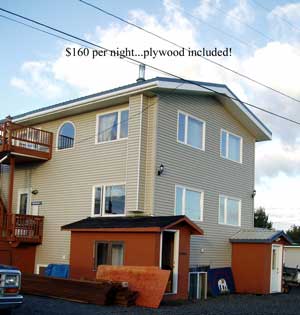 ing
our gun cases and ammo case with our boxed hunting gear in secure
storage at Renew Air Taxi headquarters (owned by
Kniktuk Outfitters), Cindy Wener took us into Dillingham to a
bed-and-breakfast to spend the night. This was our second lesson
in the expense of living in Alaska: a very marginal bed-and-breakfast,
where we had no towels and had to fix our own breakfast, was a
smooth $160/night!
ing
our gun cases and ammo case with our boxed hunting gear in secure
storage at Renew Air Taxi headquarters (owned by
Kniktuk Outfitters), Cindy Wener took us into Dillingham to a
bed-and-breakfast to spend the night. This was our second lesson
in the expense of living in Alaska: a very marginal bed-and-breakfast,
where we had no towels and had to fix our own breakfast, was a
smooth $160/night!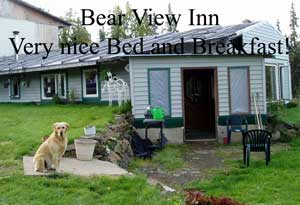 the airline
waiting area. Yup--that was it. The airline people were mystified
as to where it came from. Gives you a real secure feeling, huh?
the airline
waiting area. Yup--that was it. The airline people were mystified
as to where it came from. Gives you a real secure feeling, huh?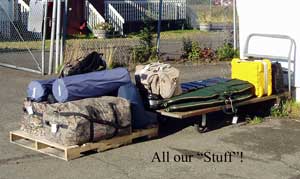 rday, September 4, dawned clear, sunny and glorious! What
a perfect day to travel. Bob Weiner and his son loaded our (small)
mountain of stuff into their turbine Otter, along with us, one
other hunter and HIS stuff, and took off for the hunting camp.
After a little over an hour flight over some of the most spectacular
terrain, we touched down on Lake Chauekuktuli (pronounce
rday, September 4, dawned clear, sunny and glorious! What
a perfect day to travel. Bob Weiner and his son loaded our (small)
mountain of stuff into their turbine Otter, along with us, one
other hunter and HIS stuff, and took off for the hunting camp.
After a little over an hour flight over some of the most spectacular
terrain, we touched down on Lake Chauekuktuli (pronounce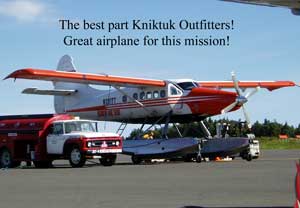 d: Chow'-kuck-two'-lee).
There, after off-loading and sorting out all the hunting gear,
food and provisions, we were introduced to our guide, Jim Howe,
and our packer, Donny Price. Jim is a taxidermist from Montana,
and a licensed guide. Donny is a baseball player from Reno; this
was his second year in Alaska.
d: Chow'-kuck-two'-lee).
There, after off-loading and sorting out all the hunting gear,
food and provisions, we were introduced to our guide, Jim Howe,
and our packer, Donny Price. Jim is a taxidermist from Montana,
and a licensed guide. Donny is a baseball player from Reno; this
was his second year in Alaska. 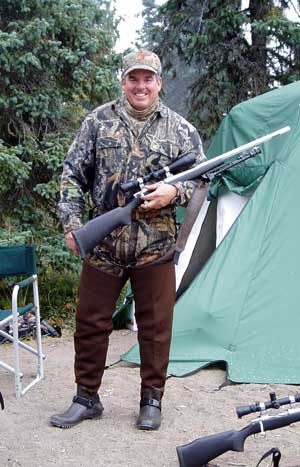 ntroduced me to the 3 types of terrain
you find in Alaska:
ntroduced me to the 3 types of terrain
you find in Alaska: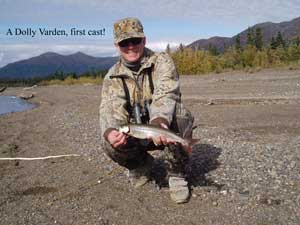 nut
butter/jelly lunch, we jumped in the skiff, and headed down to
the other Kniktuk camp, to admire the bull. To our huge disappointment,
we found out the truth: George was on the bull, ready to pull the
trigger, when another hunter from another camp further east on
the lake shot the bull out from under him. Phil, George's guide,
was so angry he was spitting nails. The LAST thing any of us expected
on a hunt in Alaska was to run into other hunters!
nut
butter/jelly lunch, we jumped in the skiff, and headed down to
the other Kniktuk camp, to admire the bull. To our huge disappointment,
we found out the truth: George was on the bull, ready to pull the
trigger, when another hunter from another camp further east on
the lake shot the bull out from under him. Phil, George's guide,
was so angry he was spitting nails. The LAST thing any of us expected
on a hunt in Alaska was to run into other hunters!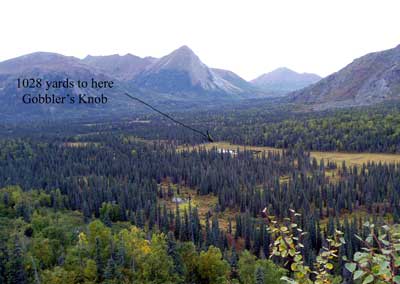 top of a promontory
providing excellent view of a large number of meadows, with shooting
opportunities out to a thousand yards. He felt it was tailor-made
for us snipers. He also felt confident the area would be undisturbed,
even with the abundance of hunters in the area, due to the very
difficult climb to get to the top of the knob, and that the meadows
were a hard 1-2 mile walk from the shore of the lake.
top of a promontory
providing excellent view of a large number of meadows, with shooting
opportunities out to a thousand yards. He felt it was tailor-made
for us snipers. He also felt confident the area would be undisturbed,
even with the abundance of hunters in the area, due to the very
difficult climb to get to the top of the knob, and that the meadows
were a hard 1-2 mile walk from the shore of the lake.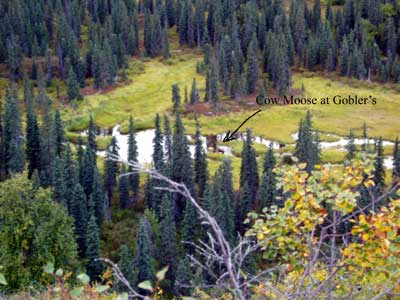 adventure, but we planned on returning
many times--the spot was just too promising to ignore!
adventure, but we planned on returning
many times--the spot was just too promising to ignore!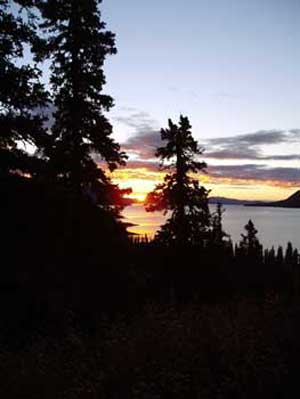 We stopped by
George and Phil's camp on the way, to pick up our provisions. Unfortunately,
our provisions consisted of a bag of egg noodles and a small jar
of cooking oil. Evidently, Bob & Cindy hadn't gotten our want
list! Jim called in the order on the satellite phone Bob had left
with Phil, and we headed back to our camp to scratch together a
meal. We used up the last of the bread at lunch.
We stopped by
George and Phil's camp on the way, to pick up our provisions. Unfortunately,
our provisions consisted of a bag of egg noodles and a small jar
of cooking oil. Evidently, Bob & Cindy hadn't gotten our want
list! Jim called in the order on the satellite phone Bob had left
with Phil, and we headed back to our camp to scratch together a
meal. We used up the last of the bread at lunch.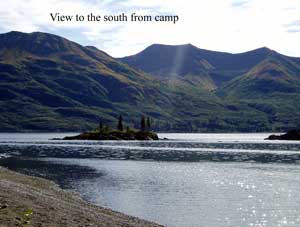 ing
nothing but 3 other hunters (who were obviously trying to figure
out how to get where we were!), we headed out at last light. For
supper, I cut up a ham into ham steaks and fried them in pancake
syrup. Thank goodness for my southern roots--we wolfed those ham
steaks down! We agreed to ration what food we had, to stretch it
until we got reprovisioned. Since our tent floor had turned into
a mudpit (dirt tracked in on our boots plus water leaking in from
the rain), Dale and I were now thoroughly uncomfortable. There's
just nothing like having to hang up 10 or 12 wet pieces of clothing
in a small tent, trying to dry them out without the aid of a heater.
We found we could turn the one Coleman lantern we had on full-blast,
to help warm the tent and dry out the clothes.
ing
nothing but 3 other hunters (who were obviously trying to figure
out how to get where we were!), we headed out at last light. For
supper, I cut up a ham into ham steaks and fried them in pancake
syrup. Thank goodness for my southern roots--we wolfed those ham
steaks down! We agreed to ration what food we had, to stretch it
until we got reprovisioned. Since our tent floor had turned into
a mudpit (dirt tracked in on our boots plus water leaking in from
the rain), Dale and I were now thoroughly uncomfortable. There's
just nothing like having to hang up 10 or 12 wet pieces of clothing
in a small tent, trying to dry them out without the aid of a heater.
We found we could turn the one Coleman lantern we had on full-blast,
to help warm the tent and dry out the clothes.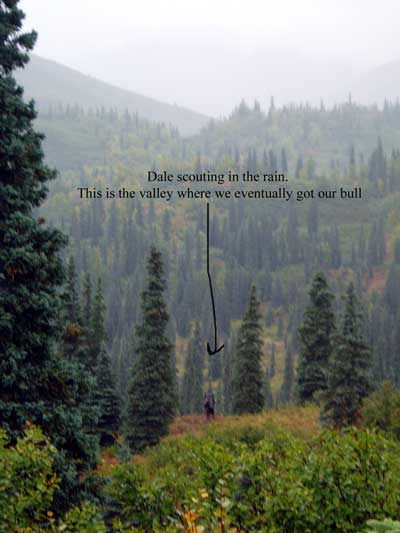 ted by no supper--we were just about
out of food!
ted by no supper--we were just about
out of food!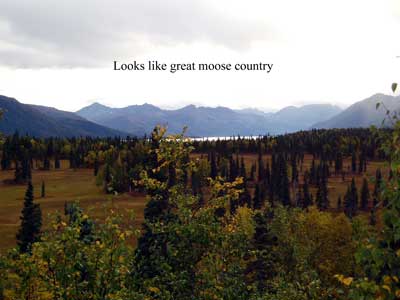 Well, this whole situation just about sent Dale over the edge.
He got out our satellite phone and called Bob. As soon as Bob answered,
Dale asked him when he planned on reprovisioning us. Bob laughed,
and said he'd wondered what we were eating--tree bark? Dale simply
answered, “I’m not laughing…..”
Well, this whole situation just about sent Dale over the edge.
He got out our satellite phone and called Bob. As soon as Bob answered,
Dale asked him when he planned on reprovisioning us. Bob laughed,
and said he'd wondered what we were eating--tree bark? Dale simply
answered, “I’m not laughing…..”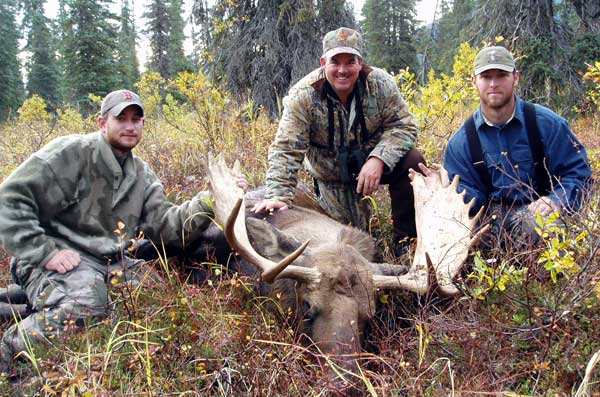 til he was only 200
yards away. He wasn't huge, but he was coming in, and looked gorgeous
to me and Dale! He stopped at the base of the bluff we were sitting
on--a whopping 73 yards away. He raked branches of a tree, determined
to confront the “moose” that kept grunting back at
him (Jim’s call). He pawed an area, urinated in it, and decided
to bed down, waiting on this “moose” who refused to
reveal himself. Meanwhile, Jim would call occasionally, and the
bull would answer every time. It was fascinating watching his behavior!
til he was only 200
yards away. He wasn't huge, but he was coming in, and looked gorgeous
to me and Dale! He stopped at the base of the bluff we were sitting
on--a whopping 73 yards away. He raked branches of a tree, determined
to confront the “moose” that kept grunting back at
him (Jim’s call). He pawed an area, urinated in it, and decided
to bed down, waiting on this “moose” who refused to
reveal himself. Meanwhile, Jim would call occasionally, and the
bull would answer every time. It was fascinating watching his behavior! 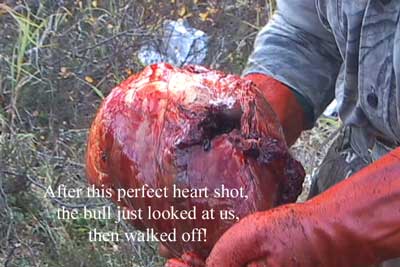 pieces.
pieces.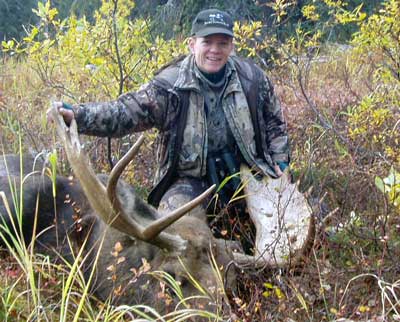 e started the final trip out. Donny had
the two sacks of piece meat. Dale had his rifle, the moose skull/horns,
and his day pack. I had my pack, my rifle, and Jim's rifle. Jim
had loaded his pack with the cape and the hide, but forgot to readjust
the straps from where Dale had used them. He ended up on his back
like a turtle! Fortunately, no harm done. Also, it was an easy,
firm 1 mile walk to the shore line and the skiff.
e started the final trip out. Donny had
the two sacks of piece meat. Dale had his rifle, the moose skull/horns,
and his day pack. I had my pack, my rifle, and Jim's rifle. Jim
had loaded his pack with the cape and the hide, but forgot to readjust
the straps from where Dale had used them. He ended up on his back
like a turtle! Fortunately, no harm done. Also, it was an easy,
firm 1 mile walk to the shore line and the skiff.